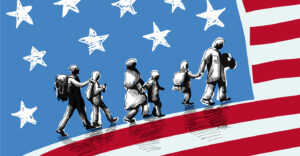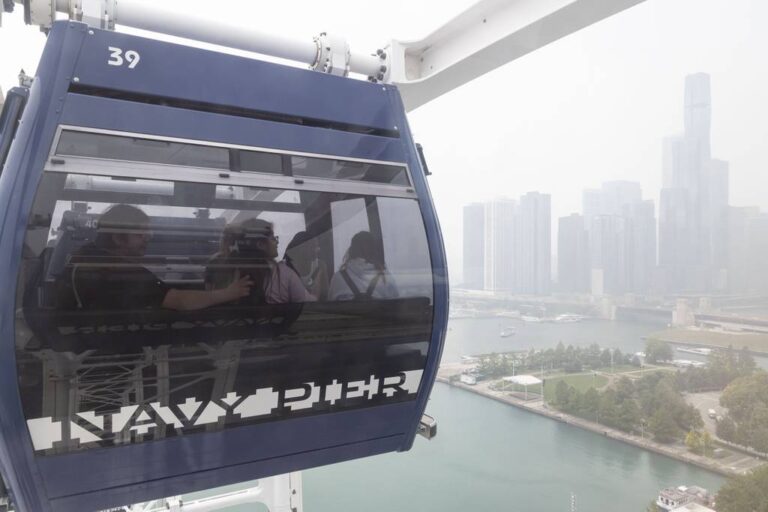Canada is experiencing one of its worst wildfire seasons in modern history, and experts said climate change is increasing the fires’ intensity, frequency and reach.
“Fire is inevitable and climate change will make it more common and more dangerous,” said Mohammad Reza Alizadeh, a climate researcher with Massachusetts Institute of Technology and McGill University in Quebec. “And that means more people are likely to be affected by larger and larger fires, even catastrophic ones.”
Alizadeh said there’s a direct effect on people living near places prone to burning, but there are also those affected indirectly by the smoke that can travel thousands of miles.
Last month, Chicago and several other cities in the United States were under dayslong air quality alerts due to lingering smoke. Breathing in smoke has a plethora of negative health effects. On Sunday, as wildfire smoke once again blew into the region, air quality was considered unhealthy for everyone in the Chicago area, according to AirNow, a website combining county, state and federal air quality data.
The Canadian Interagency Forest Fire Centre keeps track of current fires in the country and is updated daily. As of Sunday, nearly 25 million acres of land had burned this year — about 15 times greater than last year’s burned area. This year’s numbers also vastly surpass the 10-year average of 2.9 million acres burned.
The forest fire center also assigns Canadian provinces and the whole country a preparedness level ranging from one through five based on fuel and weather conditions, fire activity and available resources. Marieke deRoos, a spokesperson for the center, said all of Canada has been at level five, the highest alert, since May 11.
In Quebec, one of the hardest-hit provinces this season, 3.7 million acres of land have been burned, according to the Quebec Provincial Forest Fire Control Agency. Compared to the historic yearly average of half a million acres burned, this season is “unprecedented,” said Mélanie Morin, spokesperson for the agency.
Preparedness level five in Canada means regional resources are stretched thin and international support has been requested from countries such as Australia, New Zealand, South Africa, the United States, Mexico, South Korea and Costa Rica.
“The trend is that there are fewer fires and that they’re burning bigger and more intensely,” deRoos said.
The factors that contribute to wildfire severity boil down to weather conditions and the amount of fuel or burnable material. When it comes to climate change, experts said it’s hard to pinpoint one thing contributing to worsening wildfire seasons.
Alizadeh said climate change is warming up the Arctic, which directly affects weather patterns in Canada. Warming temperatures in the Arctic are slowing the jet stream, which are large winds that move along weather systems. This means droughts last longer and rainfall is heavier.
Experts said droughts create ideal conditions for wildfires in the northern forests of Canada to burn longer. And more rain leads to vegetation growth, increasing how much fuel is available to burn. Research shows that there’s a risk for both more fires and ones that are harder to put out.
“Climate change is predicted to cause a larger increase in the number of, you know, very hot and dry days across the country,” Alizadeh said. “And this means our forests are likely to become much more flammable in many regions.”
Large wildfires, like the ones in Canada, need dry fuel. And climate change is exacerbating dry conditions.
“The fuels are drying faster, they’re staying dry for longer,” said John Abatzoglou, a climatology professor at the University of California at Merced. “There’s more of the landscape that is receptive to igniting because it’s drying up and then carrying fire.”
If warm and dry conditions occur over a large enough area, it sets the stage for fires that resist containment, Abatzoglou said.
Climate change is also a concern for those studying wildfires in the United States, like Abatzoglou, who said the West is entering “prime fire season.”
“So far, it has been very, very quiet,” he said. “There’s still time for things to, you know, switch on a dime.”
Many parts of the country are currently experiencing drought and the frequency and length of droughts are expected to increase as the planet warms.
Areas of the Pacific Northwest are experiencing “severe drought,” according to the U.S. Drought Monitor. But Abatzoglou notes that wildfires don’t necessarily need long-term drought conditions to start.
“What you do need is for your fuels to dry out and that could happen over a period of a month or two, what we have been referring to as a flash drought,” he said.
On the flip side, areas experiencing a lot of rain this year might not be spared, either, such as in the Southwest.
“After a wet year, there ends up being a lot more fuel and that generally favors an active fire season in the subsequent year,” Abatzoglou said.
Among all the factors that a warming planet is expected to change when it comes to wildfires, Abatzoglou is most concerned for the increasing number of people affected, especially during large, “synchronous fire events” such as those in Canada.
“That results in a significant strain to fire protection resources, and obviously, it’s impacting both local and downstream air quality and human health, which some of those numbers are quite, quite crazy to think about,” he said.
During one of the two days in late June when Chicago was under an air quality alert, the city recorded the worst air quality in the world, according to an international index.
In Illinois, wildfire season isn’t as intense as in the West, but Thomas Richter of the Illinois Fire Service Institute said state drought conditions have made for bad ground cover fires this summer.
“When people talk about climate change, obviously, the Earth’s climate has changed for hundreds of thousands of years in a cyclic manner,” Richter said. “And we’re hitting that again, we’re hitting this cycle where things are just strained all over.”
Experts said that good fire management practices can prevent larger fires from happening. One practice is prescribed fire or intentional burning under controlled conditions.
Richter leads the wildland firefighting program at the institute, the state fire training academy. He said the institute, one of many around the country, trains firefighters where they are, whether it’s in Canada or the U.S. West. One of the main teaching points is that fire can be a suppressant tool.

Afternoon Briefing
Weekdays
Chicago Tribune editors’ top story picks, delivered to your inbox each afternoon.
“It’s a very weird kind of thing to say,” Richter said. “Sometimes we use fire to, to rid ourselves of fuel along you know, the edge of a burn. When there’s no fuel, it can’t burn.”
While each Canadian province and agency has its own strategies for managing wildfires, there’s generally increased focus on how some burning can be beneficial, said deRoos, the spokesperson with the forest fire center. Whereas in the past, the strategy was to suppress all fires.
So when discussing the record-breaking wildfire season, deRoos said to keep these changing ideas of fire and the landscape in mind.
“There’s so much more fuel on the landscape because it just simply didn’t have a chance to burn in the past,” deRoos said.
But experts at all these levels agree that wildfire seasons are getting longer. Richter said he doesn’t think there’s a true fire season anymore.
“They just seem to be all the time, all year,” he said. “We’re not getting a break.”







